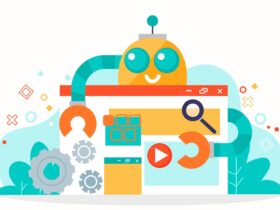Low-code and no-code development solutions, once a trend in the software development realm, are embracing the new generative artificial intelligence (AI) capabilities to deliver more dynamic development experiences. This combination of innovation and convenience reshapes how users engage with their applications/software. Picture an instance where creating sophisticated instructions such as “Deploy an endpoint protection for all noncompliant devices” is as easy as chatting with your app.
The integration of generative AI services with no-code/low-code platforms enables you to redefine your app’s behavior without digging into technical intricacies. For instance, you can input natural language prompts like “Create a workflow for automating inventory updates” or “Write a code for changing date formats.” Generative AI can then translate these prompts into actions, streamlining no-code/low-code development and fostering creativity. In this article, we further explore the growing impact of generative AI services on no-code/low-code development.
What is No-code/low-code Development?
Low-code and no-code development has become popular in recent times. Initially, developers had to create software code from scratch. This made the development process more time-consuming. As a result, new approaches (no-code/low-code) to software development emerged to streamline the process.
Low-code development platforms allow users to create complex applications and software with minimal coding skills. On the other hand, no-code development platforms do not demand programming knowledge at all. These development solutions have empowered users of all expertise to build applications despite not having advanced coding experience.
Generative AI and No-code/low-code Development
Generative AI is a subset of AI technology that produces different types of content, including synthetic data, audio, images, and text. The recent rise in generative AI popularity has been driven by the simplicity of generative AI tools to create high-quality content, videos, and graphics in seconds.
These advanced abilities have made generative AI a popular technology across many industries, including software development. One software development approach that has widely benefitted from generative AI is no-code/low-code development.
8 Ways Generative AI is Impacting No-code/low-code Development
Here’s how generative AI is impacting no-code/low-code development approaches:
1. Code Generation and Automation
Low-code development platforms require users to create some components of the code. Generative AI can help generate code for complete modules or snippets depending on high-level specifications. This further accelerates the development process, enabling users to focus on application functionality and logic rather than manual coding.
2. Natural Language Processing for User Requirements
When building a low-code or no-code app, you must clearly outline your requirements and intent. This way, you can create an application that meets specified goals and objectives. Generative AI, powered by natural language processing (NLP), can understand and interpret natural language requirements. This empowers low-code and no-code developers to describe the desired functionality in plain language, and the AI can translate these requirements into code or suggest relevant components.
3. Enhanced User Interfaces (UIs)
Creating UI for your no-code/low-code app can be challenging. It would be best if you considered various factors, including usability, design principles, and more. If the UI is poor, users will not use the app for a long period. Also, they might raise complaints, leading to poor market performance. Fortunately, generative AI can help.
Generative AI can automatically create enhanced user interface elements for your application based on user input and design principles. This simplifies the process of developing functional and visually appealing user interfaces without manual design efforts.
4. Bug Detection and Fixing
No-code/low-code applications must be tested extensively to ensure they’re free of bugs and glitches. The testing process can be time-consuming, especially when done manually. This results in delays in software release. But how does generative AI impact bug detection in no-code/low-code development?
Well, generative AI automates the process of testing software for bugs and glitches. It can analyze code, identify possible issues, and even suggest fixes. This helps maintain the quality of your low-code application and minimizes the need for extensive manual testing.
5. Collaboration and Co-Creation
Software development has traditionally been recognized as an industry for expert developers. This means that only technical teams were involved in developing the software, creating a communication gap between technical and non-technical members. However, low-code and no-code development platforms have empowered non-technical teams to create apps despite having minimal coding experience.
Generative AI has further enabled collaboration between technical and non-technical stakeholders. For instance, non-technical members can use natural language prompts to translate their ideas into functional components. Also, they can use it to further understand complex components of software development. This way, they can actively collaborate on projects with technical teams to create better applications. Also, it bridges the knowledge gap between both teams, ensuring everyone is on the same page.
6. Software Interaction Efficiency
The combination of generative AI and no-code/low-code development reshapes the efficiency of software interaction. Low-code and no-code tasks that initially required careful coding or configuration can be run through simple natural language prompts. Whether creating data transformation scripts and email templates or orchestrating multi-step app workflows, generative AI accelerates results and eliminates barriers, enhancing convenience.
7. Reduced Development Time and Cost
Low-code and no-code development platforms accelerate development time by abstracting sophisticated code into simple graphical interfaces. As a result, they allow users to drag and drop elements onto the application and define its behavior. Generative AI further reduces no-code/low-code development time and cost by automating different development aspects, enabling rapid iteration and prototyping.
8. Continuous Learning and Improvement
The software development world is constantly evolving. Therefore, no-code/low-code development platforms and practices, including low code services, must keep up with the emerging needs. Generative AI models can help with that. These models can learn from user feedback and interactions, improving the ability to create code that aligns with user expectations. This iterative learning process results in ongoing enhancements in no-code/low-code development efficiency.
Final Thoughts
The impact of generative AI on no-code/low-code development is substantial, from automating code generation and testing to enhancing UI design and promoting continuous improvement. However, these technologies are still evolving. Therefore, challenges like ensuring the generated code meets security and ethical standards must be addressed to ensure seamless integration. As this collaboration matures, the no-code/low-code development landscape is poised for a significant change, further shaping the future of software development.








Leave a Reply